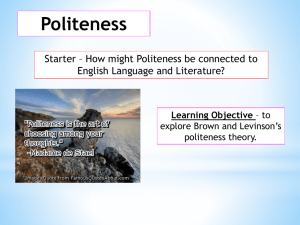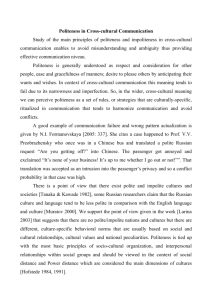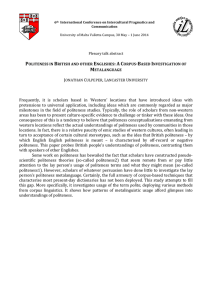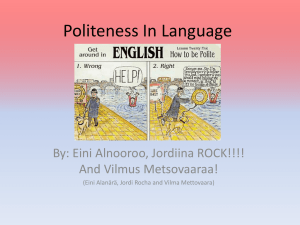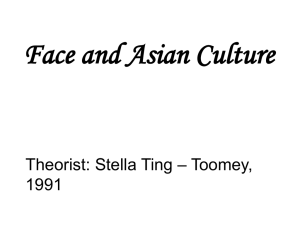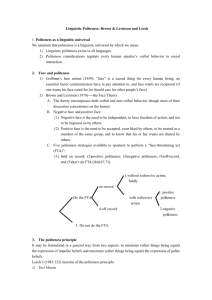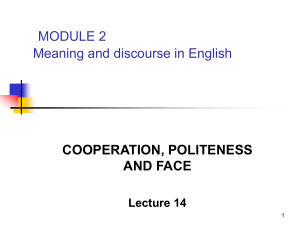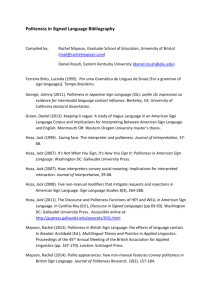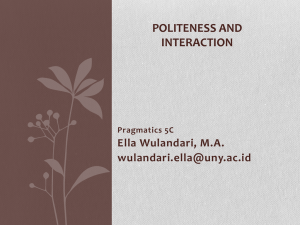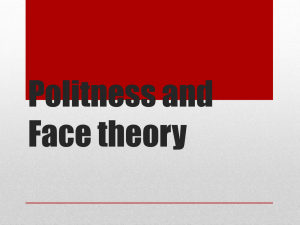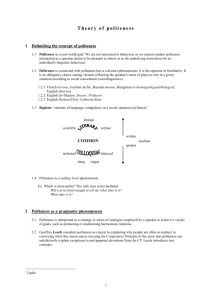Politeness - WordPress.com
advertisement
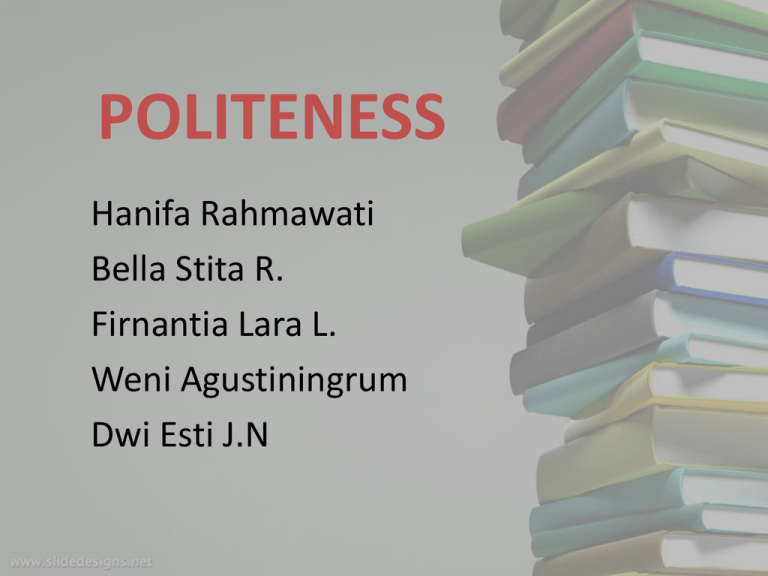
POLITENESS Hanifa Rahmawati Bella Stita R. Firnantia Lara L. Weni Agustiningrum Dwi Esti J.N DEFINITION OF POLITENESS • Polite social behaviour within a certain culture. • The ability of participants in a social interaction to engage in interaction in an atmosphere of relative harmony (Geoff Leech). POLITENESS • Politeness and face • Politeness maxims • Politeness and context POLITENESS AND FACE a) b) c) d) e) Off - record On - record Apology and Hesitation Negative Politeness Positive Politeness a speaker's sense of linguistic and social identity. a) Off - record ask for help indirectly, and say, in a voice loud enough for your neighbor to hear. Example: “I forget where I put my car key. I wish I could remember it.” b) On - record a speaker makes a suggestion request over or invitation in an open and direct way. Example: “Put your jacket away.” c) Apology and Hesitation a question giving them the opportunity to say no. Example: 1.“Sorry to bother you. I have been looking for my car key three times but I cannot find it. Do you mind to help me looking for my car key if you have nothing to do?” -instead of2.“Would you mind to help me looking for my car key?” d)Negative Politeness Speakers can minimize the imposition by making it seems smaller than it is, or by adding devices such as hedges that mitigate the imposition. Example: “Would you mind moving just slightly? I can’t see the screen very clearly.” e)Positive Politeness Strategies aim to save positive face, by demonstrating closeness and solidarity, appealing to friendship, making other people feel good, and emphasizing that both speakers have a common goal. Example: “I know you hate live music concert, Anne, but, please come anyway. We’ll all be there. Daniel and his girlfriend are going to come too. Come on-can’t wait for Dream Theater concert! Rock the night!” POLITENESS MAXIMS a) Tact and Generosity b) Approbation and Modesty c) Agreement d) Sympathy e) Overlaps and Gaps a) Tact and generosity : maximize benefit to other; minimize benefit to self. Example : “You relax and let me do the dishes.” b) Approbation and modesty : minimize dispraise of other; and maximize praise of other. Example : “You’d better go with Daniel, his car is more luxurious than mine.” c) Agreement : “minimize disagreement between self and other” and “maximize agreement between self and other” Example : “Yes, yes, but if you do that it will make her dissapointed.” d) Sympathy : “minimize antipathy between self and other” and “maximize sympathy between self and other” Example : “I am sorry to hear that.” e) Overlaps and Gaps : one utterance can contain both positive and negative politeness. Example : “You may make a party tonight in your room but don’t be too noisy.” POLITENESS AND CONTEXT • Form and function • Situational context • Cultural context • Form and Function Politeness lies not in the form and the words themselves but in their function and intended social meaning. The form is polite, but the intention is not polite. Example : 1. “So, if you’d be as kind as to shut up, I’d appreciate it.” 2. “Wallet, would you please give me some money for my dinner tomorrow?” • Situational context 1. “Hang on-I haven’t finished!” 2. “I wonder if I might just say finish what I’m trying to say.” • Cultural context 1. “You should not use too much media for your presentation if it is useless.” 2. “Make it clearer so that everyone here can see it.” THANK YOU
